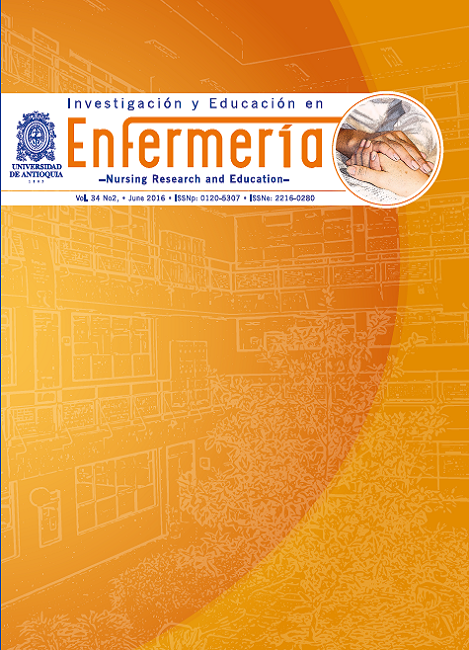Caregiver role strain: bi-national study of content validation
DOI:
https://doi.org/10.17533/udea.iee.323261Keywords:
Nursing, caregivers, validation studies.Abstract
Objective. To estimate content validity of the diagnosis Caregiver Role Strain.
Methods. Content validation of the defining characteristics according to Fehring’s model was undertaken by 6 Colombian nurses and 9 Brazilian counterparts. The relevance of each defining characteristic for the diagnosis was assessed using 5-point Likert type scale. The Mann-Whitney test was used to estimate differences in assessing the relevance of defining characteristics between Brazilian and Colombian nurses.
Results. From 36 defining characteristics, 22 were identified as major, 13 as secondary and one as irrelevant (rash). The content validity index (sum of weighted averages divided by the total number of defining characteristics) was 0.79, considered adequate.
Conclusion. Most of the defining characteristics were considered relevant to the nursing diagnosis Caregiver Role Strain. These findings reflect consensus among specialists from two different countries in relation to the relevance of the defining characteristics for this diagnosis.
How to cite this article: Rueda LJ, Cruz DALM, Silva RCG. Caregiver role strain: bi-national study of content validation. Invest. Educ. Enferm. 2016; 34(2):
Downloads
References
(1) Leite AL. Classificações de diagnóstico e intervenção de enfermagem : NANDA-NIC. Acta Paul Enferm. 2009;22:864–7.
(2) Fehring R. Methods to validate nursing diagnoses. Hear Lung. 1987;16(6 Pt 1):625-9.
(3) Herdman TH. North American Nursing Diagnosis Association (NANDA) Nursing Diagnoses: Definitions and Classifications 2012–2014. Oxford: Wiley-Blackwell; 2012.
(4) Caldeira SMA, Chaves ECL, Carvalho EC, Vieira MM. Validation of nursign diagnoses, the differential diagnostic validation model as a strategy. Rev. Enferm. UFP. 2012; 6(6):1441–5.
(5) Montefusco SRA, Bachion MM, Vera I, Caixeta CMD. Tensão do papel de cuidador: ocorrência em familiares de pessoas com doenças crônicas hospitalizadas. Cienc Cuid Saude. 2011;10(4):828–35.
(6) Lund L, Ross L, Petersen MA, Groenvold M. Cancer caregiving tasks and consequences and their associations with caregiver status and the caregiver’s relationship to the patient: a survey. BMC Cancer. 2014; 14:541.
(7) Wong WK, Ussher J. Bereaved informal cancer carers making sense of their palliative care experiences at home. Health Soc. Care Community. 2009; 17:274–82.
(8) Thombre A, Sherman AC, Simonton S. Religious coping and posttraumatic growth among family caregivers of cancer patients in India. J. Psychosoc. Oncol. 2010; 28:173–88.
(9) WK, Ussher J, Perz J. Strength through adversity: bereaved cancer carers' accounts of rewards and personal growth from caring. Palliat. Support Care. 2009; 7:187–96.
(10) Mackenzie A, Greenwood N. Positive experiences of caregiving in stroke: a systematic review. Disabil. Rehabil. 2012; 34(7):1413–22.
(11) Zeleníková R, Kozáková R, Jarošová D. Clinical Validation of the Nursing Diagnosis Caregiver Role Strain in the Czech Republic. Int. J. Nurs. Knowl. 2014; 25(2):80–4.
(12) Oliveira AR, Rodrigues RC, de Sousa VE, Costa AG, Lopes MV, de Araujo TL. Clinical indicators of “caregiver role strain” in caregivers of stroke patients. Contemp. Nurse. 2013; 44(2):215–24.
(13) Thoroddsen A, Thorsteinsson H. Nursing diagnosis taxonomy across the Atlantic Ocean: Congruence between nurses’ charting and the NANDA taxonomy. J Adv Nurs. 2002;37(4ho):372–81.
(14) Carpenito LJ. Nursing Diagnosis Application to Clinical Practice. 13th ed. United Stated of America: Lippincott; 2010. P.13.
(15) Gordon M. Pasado, presente y futuro de los diagnósticos de enfermería. Cult. Cuid. 2000; (7-8):128–38.
(16) Martins QC, Meireles P, Rabelo E, Aliti G. Definiçoes conceituais e operacionais das caracteristicas definidoras do diagnóstico de enfermagem débito cardíaco diminuído. Rev. Enferm. UFSM. 2012; 2(2):420-33.
(17) Torimoto-Sasai Y, Igarashi A, Wada T, Ogata Y, Yamamoto-Mitani N. Female family caregivers face a higher risk of hypertension and lowered estimated glomerular filtration rates: a cross-sectional, comparative study. BMC Public Health. 2015;15:177.
(18) Gallagher S, Phillips AC, Drayson MT, Carroll D. Caregiving for children with developmental disabilities is associated with a poor antibody response to influenza vaccination. Psychosom. Med. 2009; 71(3):341–4.
(19) Lovell B, Wetherell MA. The cost of caregiving: Endocrine and immune implications in elderly and non elderly caregivers. Neurosci. Biobehav. Rev. 2011; 35(6):1342–52.
(20) Nielsen M, Hansen J, Ritz B, Nordahl H, Schernhammer E, Wermuth L, et.al. Cause-Specific Mortality Among Spouses of Parkinson Disease Patients. Epidemiology. 2014; 25(2):225-32.
Downloads
Published
How to Cite
Issue
Section
License
Derechos de propiedad / Direitos de Propriedade
English: If the article is accepted for publication, all copyright will be of exclusive property of Investigación y Educación en Enfermería. The text and the graphics included in the publication are exclusive responsibility of the authors and not necessarily reflect the thought of the Editorial Committee.
Español: Si el artículo es aprobado para publicación, todos los derechos son de propiedad de Investigación y Educación en Enfermería. El texto y las gráficas incluidas en la publicación son de exclusiva responsabilidad de los autores y no necesariamente refleja el pensamiento del Comité Editorial.
Português: Se o artigo for aceito para publicação, todos os direitos autorais serão de propriedade exclusiva de Investigación y Educación en Enfermería. O texto e os gráficos incluídos na publicação são de responsabilidade exclusiva dos autores e não refletem necessariamente o pensamento do Comitê Editorial.















